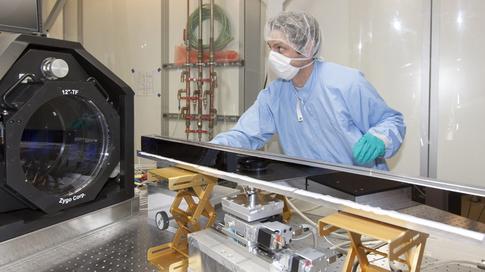XFEL: World’s most precise mirror arrives in Hamburg
World’s most precise mirror arrives in Hamburg
A 95-cm long mirror that is more precise than any other yet built was delivered to European XFEL, an X-ray laser research facility that is under construction in the Hamburg area of Germany. The mirror is superflat and does not deviate from its surface quality by more than one nanometre, or a billionth of a metre. It is the first of several of its kind needed for the European XFEL. Each will be essential to the facility’s operation, enabling scientists from around the globe to reliably use the world’s brightest X-ray laser light for research into ultrafast chemical processes, complex molecular structures, and extreme states of matter. The precision of the European XFEL mirror is equivalent to a 40-km long road not having any bumps larger than the width of a hair. The mirror’s production is the culmination of a long research and development process involving several institutes and companies in Japan, France, Italy, and Germany.
The mirror body, with a 95 cm long and 5.2 cm wide reflective face, is made from a single crystal of silicon that was crafted by industrial partners in France and Italy. In order to polish a mirror of the required length to European XFEL’s nanometre specification, the optics company JTEC in Osaka, Japan, used a new polishing method using a pressurized fluid bath capable of stripping atom-thick layers off of the crystal. This development required the construction of a brand-new facility that would be able to meet the exceptional demands from the European XFEL, while also expanding the company’s ability to serve other, similar facilities, such as the LCLS in the U.S. and SwissFEL in Switzerland. The polishing technique alone took nearly a year to develop to a point where the extreme quality could be reached.

The mirrors have to be so precise because of the laser properties of the X-rays at the European XFEL. These properties are essential to clearly image matter at the atomic level. Previously, European XFEL simulations had shown that any distortions in the mirrors greater than one nanometre would cause the properties of the laser spot on the sample to be degraded.
Mirrors of this series will be used to deflect the X-rays by up to a few tenths of a degree into the European XFEL’s six scientific instruments in its underground experiment hall in the town of Schenefeld. This is done because the instruments, which are parallel to each other, will eventually be able to operate in parallel, enabling scientists to have greater access to the facility and its unique X-ray light. Additionally, similar mirrors will focus the X-ray light within some of the facility’s instruments.
However, the particular mirror that was delivered is needed for filtering the light generated by the facility to only the kind needed for experiments. Within the European XFEL’s X-ray laser light-generating structures, called undulators, some undesirable wavelengths of light are produced. A set of these superflat mirrors will be arranged after each undulator in the facility’s underground tunnels, and the position of each mirror allows for only the desired wavelength of laser light to continue towards the experiment hall. The undesirable wavelengths of light are more energetic and pass through the mirror instead of reflecting, ending up in an adjacent absorber made of boron carbide and tungsten.
The mirror will now be measured at European XFEL and Helmholtz Zentrum Berlin for additional verification of its specifications. Three more mirrors of the same type are due to arrive at European XFEL in May.
A high resolution picture is available on our media database.
